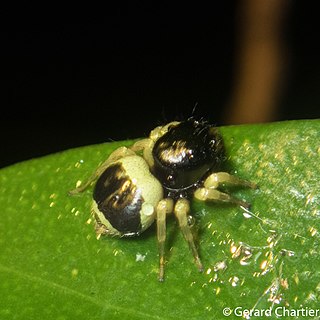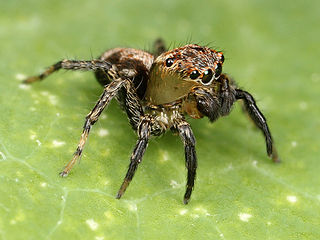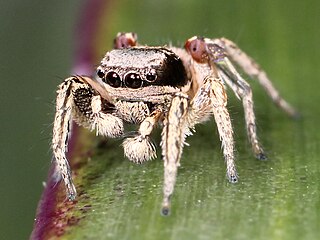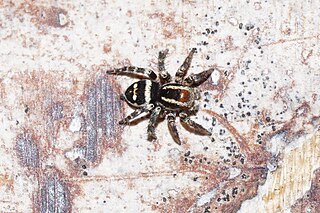Nebridia is a monotypic genus of Venezuelan jumping spiders containing the single species, Nebridia semicana. It was first described by Eugène Louis Simon in 1902, and is only found in Venezuela. It was briefly considered a synonym of Amphidraus, it was elevated to genus status in 2017.

Nicylla is a monotypic genus of Sumatran jumping spiders containing the single species, Nicylla sundevalli. It was first described by Tamerlan Thorell in 1890, and is only found on Sumatra. Briefly considered a synonym of Thiania, it was elevated back to genus status in 2017.

Pystira is a genus of spiders in the jumping spider family Salticidae.
Thianitara is a genus of Southeast Asian jumping spiders that was first described by Eugène Louis Simon in 1903. As of August 2019 it contains only two species, found in Thailand, Indonesia, and Malaysia: T. spectrum and T. thailandica. It was briefly considered a junior synonym of Thiania until 2017, when it was revived by Jerzy Prószyński.
Wallaba is a monotypic genus of Guyanese jumping spiders containing the single species, Wallaba metallica. It was first described by Cândido Firmino de Mello-Leitão in 1940, and is found in Guyana. It was synonymized with Sidusa in 2015, but was revalidated by Jerzy Prószyński in 2017.

Salticinae is a subfamily of jumping spiders. It includes over 90% of the known species of jumping spiders. The subfamily is divided into two unranked clades: Amycoida and Salticoida.

Salticoida is an unranked clade of the jumping spider family Salticidae. It is the larger and more widespread of the two subdivisions of the "typical" jumping spiders, occurring effectively world-wide. Its sister clade is Amycoida, which is also very diverse ecologically but has a mostly South American distribution.

Simonellini is a tribe of spiders belonging to the Amycoida clade of the subfamily Salticinae of the family Salticidae. The group has been treated at a variety of formal and informal ranks, with different circumscriptions, including as the subfamilies Synemosyninae and Simonellinae. Its species mimic ants and beetles.
Ragatinus is a genus of spiders in the family Salticidae. It was first described in 2016 by Angelika Dawidowicz and Wanda Wesołowska. As of 2017, it contains only one species, Ragatinus maddisoni.
Edwardsya is a genus of spiders in the family Salticidae. It was first described in 2016 by Ruiz & Bustamante. As of 2017, it contains 2 species, both from Brazil. The genus is placed in subtribe Freyina, part of the Salticoida clade in the subfamily Salticinae.
Hermosa is a genus of jumping spiders first described by G. W. Peckham and E. G. Peckham in 1892, and synonymized with Myrmarachne in 1901. In 2016, Jerzy Prószyński split up Myrmarachne, creating nine new genera, all with names beginning "Myrm". However, it turned out that Myrmavola volatilis, the type species of Myrmavola, was also the type species of Hermosa, and Myrmavola was made a junior synonym. It is part of the Myrmarachnini tribe within the Salticoida clade of Salticinae.
Nepalicius is a genus of spiders in the family Salticidae. It was first described in 2016 by Prószyński. As of 2017, it contains 3 species.
Papuaneon is a genus of spiders in the family Salticidae. It was first described in 2016 by Maddison. It is placed in the tribe Neonini, part of the Salticoida clade of the subfamily Salticinae.
Orcevia is a genus of Asian jumping spiders first described by Tamerlan Thorell in 1890. Laufeia, circumscribed to include Orcevia, is placed in the tribe Euophryini in the Salticoida clade of Salticinae. It was once considered a synonym of Laufeia, but it was revalidated in 2019.
Junxattus is a monotypic genus of southeast Asian jumping spiders native to Sumatra. It contains the single species, Junxattus daiqini, first described by Jerzy Prószyński and Christa Deeleman-Reinhold in 2012. The genus was placed in the subfamily Euophryinae, the equivalent of the tribe Euophryini.

Stenaelurillus ignobilis is a species of jumping spider in the genus Stenaelurillus that lives in Zimbabwe. The female was first described in 2011 by Wanda Wesołowska and Meg Cumming. The male has yet to be described. The spider takes its name from a Latin word that can be translated unsightly. The spider is medium-sized, with a carapace 2.6 mm (0.10 in) long and abdomen 3.4 mm (0.13 in) long. The carapace is brown, covered in bristles and has an almost indiscernible stripe, while the abdomen is larger and has a stripe of lighter brown down the middle of its generally darker, nearly black, The long spinnerets are also hairy while the legs have both hairs and spines. It is similar to Stenaelurillus mirabilis but can distinguished by the design of the epigyne, and particularly the way that the gonopores are hidden in deep cup-like depressions.

Stenaelurillus striolatus is a species of jumping spider in the genus Stenaelurillus that is endemic to Nigeria. It was first described in 2011 by Wanda Wesołowska and Anthony Russell-Smith. Only the male has been identified. The spider is small, with a brown cephalothorax 2.5 mm (0.098 in) in length and black abdomen 2.4 mm (0.094 in) in length. The abdomen is marked with two shining white stripes which give the species its name. It is distinguished from other members of the genus by its clypeus, which is entirely dark brown and black.
Tartamura is a genus of South American jumping spiders first described by A. A. Bustamante & Gustavo Rodrigo Sanches Ruiz in 2017. Tartamura was placed in the tribe Thiodinini, part of the Amycoida clade of the subfamily Salticinae in Maddison's 2015 classification of the family Salticidae.
Matinta is a genus of South American jumping spiders. The largest number of species are found in Brazil.

The Sitticini are a tribe of spiders in the family Salticidae. The tribe has been divided into two subtribes, Aillutticina, with five Neotropical genera, and Sitticina, with five genera from Eurasia and the Americas. One genus is unplaced within the tribe. The taxonomy of the tribe has been subject to considerable uncertainty. It was clarified in 2020.








